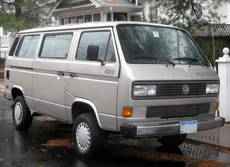 Volkswagen Vanagon syncro (US) | |
| Manufacturer | Volkswagen |
|---|---|
| Parent company | Volkswagen Group |
| Also called |
Volkswagen Transporter (T3) (Europe) Volkswagen Caravelle (T3) (Europe) Volkswagen T25 (United Kingdom & Ireland) Volkswagen Vanagon (North America) Volkswagen Microbus (South Africa) |
| Production | May 1979–June 2002[1] |
| Assembly |
Hanover, Germany Uitenhage, South Africa |
| Predecessor | Volkswagen Type 2 |
| Successor | Volkswagen Transporter (T4) |
| Class | Van |
| Layout |
Rear engine, rear-wheel drive or four-wheel drive |
| Platform | Volkswagen Group T3 |
| Engine(s) |
1.6 L (aircooled) F4 1.9 L (watercooled) F4 2.0 L (aircooled) F4 2.1 L (watercooled) F4 1.6 L (diesel) I4 1.7 L (diesel) I4 2.3 L (watercooled) I5 2.5 L (watercooled) I5 2.6 L (watercooled) I5 |
| Transmission(s) |
3-speed automatic 4-speed manual 5-speed manual |
| Wheelbase |
2,461 mm (96.9 in) GL syncro Camper: 2,456 mm (96.7 in) |
| Length | 4,569 mm (179.9 in) |
| Width | 1,844 mm (72.6 in) |
| Height |
1,928 mm (75.9 in) Carat: 1,735 mm (68.3 in) Camper: 2,055 mm (80.9 in) GL syncro: 2,085 mm (82.1 in) |
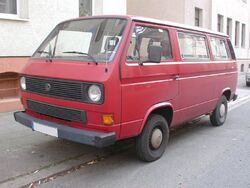
Mid-1980s Type 2 T3 Kombi

Late 1980s Type 2 T3 Caravelle syncro
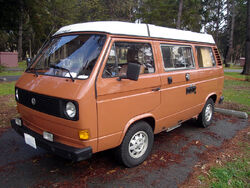
1980 Type 2 T3 Aircooled Westfalia Camper
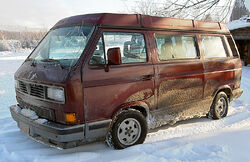
1990 Type 2 T3 Multivan
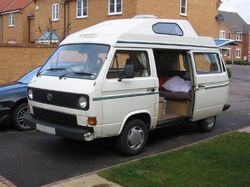
1982 T3 with Leisuredrive Crusader Conversion
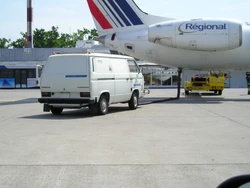
T3 as Jet Air Starter
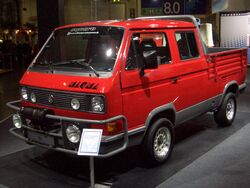
1987 Type 2 T3 syncro DoKa, DoKa deriving from German: Doppelkabine.

VW T3 Pritsche
The Volkswagen Type 2 (T3) was the third generation of the Volkswagen Transporter and was marketed under various nameplates worldwide – including as the Transporter or Caravelle in Europe, Microbus in South Africa and as the Vanagon in North and South America.
Larger and heavier than its predecessor, the T2 – and with a more squared and less rounded styling – the T3 was manufactured in Germany from 1979 until 1992. South African production of the T2 continued, for that market only, until 2002. The T3 was the last of the rear-engined Volkswagens.
History[]
Following the T2, the T3 (or Type 25) initially featured air-cooled and subsequently water cooled engines. Versions produced in South Africa from 1990 until 2002 featured an Audi five-cylinder engine.
Volkswagen marketed the Westfalia camper variant throughout the T25's (T3's) production, with features including a pop up roof, refrigerator, sink, and stove.
Examples built between 1980 and 1985 featured round headlights and chrome-plated steel bumpers with plastic end-caps. Air-cooled models (1980 to mid-1983) lack the lower grill above the radiator of the water cooled models, except on models with factory air conditioning. 1986 model year vehicles received revisions including a tachometer, more fabric choices, redesigned air conditioner, larger water cooled engine with a more advanced engine management system, and redesigned transmissions including an optional syncro four-wheel drive. Exterior changes include rectangular headlights and different paint options. Alloy wheels, larger and squarer plastic bumpers with trim along the rocker panels were optional, and standard equipment on Wolfsburg Edition vans. For 1990 and 1991 model years, a "Carat" trim level was available which included all available options (except Westfailia conversion).
All 1980 and some 1981 models had eight welded-in metal slats covering the engine ventilation passages behind the rear windows. Later models had black plastic 16-slat covers that slotted in at the top and screwed down at the bottom.
During the 1980s, the U.S. Army and Air Force in Germany used T3's as administrative (non-tactical) vehicles. In military use, the vehicle's nomenclature was "Light Truck, Commercial".
Porsche has created a version called B32 in a limited edition. The van was equipped with 3.2 liter Carrera engine and was originally developed to support Porsche 959 involvement in Paris-Dakar race.
Oettinger has developed a 6 cylinders version called WBX6. The engine is derived from the "Wasserboxer" engine and has many common parts with it. The development of the engine was originally contracted to Oettinger by VW. Oettinger bought the rights when VW decided not to use it.
Features[]
With the internal combustion engine and transaxle mounted very low in the back, the T3 had much larger disc brakes in the front, and drums in the rear. Axle weight is very nearly equal upon both the front and back ends of the vehicle. Unlike the T2 before it, the T3 was available with amenities such as power steering, air conditioning, power door locks, electrically controlled and heated mirrors, lighted vanity mirrors, and a light above the glove box (most of which were essentially standard equipment in later models).
The automatic was a standard hydraulic three-speed unit, the same 090/010 unit as used in Audis of the era. These featured a cast aluminium alloy case for the transmission section, and a cast iron case for the final drive section.
The 091 manual transmission was a four-speed unit, featuring a lightweight aluminium alloy case.
The automatic features a 1.0 ratio top gear, while the manual features a 0.85 top gear.
The oil filler tube for the engine is located behind the flip-down license plate door. Most early vans had a twist-on/off gas cap right on the outside just under and behind the passenger side door. A locking cap was optional. The spare tyre lies in a tray under the very front of the van (as the engine is in the back), just below the radiator.
Engines[]
Because of the engine placement, a T3 has nearly equal 50/50 weight distribution fore and aft.
Petrol/Gasoline[]
There were four general petrol engine variants between 1979 and 1991, with several sub-models. All were overhead valve push-rod horizontally opposed four-cylinder engines. Available engine options differed between regions.
- Air-cooled (1979–1982)
- 1.6 L (1584 cc) (50 bhp/37 kW) (Serial # CT) air-cooled, single Solex 34 PICT-4 carburettor, available on non-USA models
- 2.0 L (1970 cc) (70 bhp/51 kW) (Serial # CU or CV) air-cooled, twin Solex 34 PDSIT-2/3 carburettor or fuel injected (Bosch L-Jetronic, USA models) flat-4 in the 1980 to 1983½ models
- Water-cooled (1983 onwards)
- 1.9 litre engines:
- 1.9 L (1913 cc) (83 bhp) (Serial # DH) water-cooled (or "Wasserboxer") engine used for the 1983½ to 1985 models, which used a fuel injection system known as "Digijet" (Digital Jet-tronic)
- 1.9 L (1913 cc) (59 bhp) (Serial # DF) 8.6:1 compression ratio, 34-PICT carburetor
- 1.9 L (1913 cc) (76 bhp) (Serial # DG) 8.6:1 compression ratio, 2E3 or 2E4 carburetor
- 1.9 L (1913 cc) (55 bhp) (Serial # EY) 7.5:1 compression ratio, 34-PICT carburetor
- 1.9 L (1913 cc) (89 bhp) (Serial # GW) 8.6:1 compression ratio, Bosch Digijet electronic fuel injection
- 2.1 Litre engines:
- 2.1 L (2100 cc) (95 bhp) (Serial # MV) Wasserboxer, used until the end of Vanagon importation into the US in 1991. This engine used a more advanced engine management system known as Bosch "Digifant I" which now digitally managed ignition timing as well as fuel delivery.
- 2.1 L (2100 cc) (90 bhp) (Serial # SS) 9:1 compression ratio Wasserboxer
- 2.1 L (2100 cc) (112 bhp) (Serial # DJ) 10:1 compression ratio, Digijet injection, only sold in European countries not requiring catalytic converter.
- 1.9 litre engines:
The Wasserboxer featured an aluminum case, cylinder heads, and pistons, and a forged steel crankshaft.
The Wasserboxer, as with all VW boxer engines, directly drives the camshaft via a small gear on the crankshaft, and a large one on the camshaft that makes direct contact, so there is no timing chain or belt.
It also featured Heron, or "bowl-in-piston" type combustion chambers where the combustion takes place within the piston area, and not the cylinder head.
The switch to water-cooling for the boxer engines was made mid-year in 1983. The previous generation T2, currently produced in Brazil, has been switched to water-cooled engines since 2005.
Diesel engines[]
In contrast to the standard flat-4 gasoline engines, all diesel engine options were of an inline configuration.
- 1.6 L (1588 cc) (48 bhp) (Serial # CS) Naturally aspirated Diesel inline 4, available in the US on 1982 models only.
- 1.6 L (1588 cc) (70 bhp) (Serial # JX) Turbocharged inline 4.
- 1.7 L (1700 cc) (54 bhp) (Serial # KY) Natural aspirated inline 4.
A diesel variant of the T3 was also available and widely sold in some markets. Unfortunately the early models had a 1.6 L (1,588 cc) (48 hp) (Serial # CS) SOHC inline-four engine which rendered the van severely underpowered, with a top speed somewhere around 100 km/h (62 mph). This shortcoming was later corrected, however most likely for this reason in the North American market the diesel T3 was discontinued after three model years between 1981 and 1983. Later models received a diesel engine of the same displacement but turbocharged, which vastly improved driveability. Fuel economy of the diesel was significantly higher than that of the gasoline model, often approaching 30 mpg US.
US model variations[]
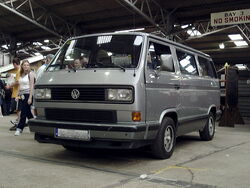
1988 California-spec VW Vanagon Wolfsburg Edition
US Vanagon model variations included the Vanagon, featuringd vinyl seats and a spartan interior; the Vanagon L with optional cloth seats, more upscale interior panels and an optional dashboard blower; the Vanagon GL with more equipment, and the Westfalia pop-top camper Vanagons, with integrated kitchen and bedding. Westfalia campers as either the standard model or as the 'Weekender,' which lacked the propane stove, sink, and domestic refrigerator of the full 'camper' versions. and offered an optional removable cabinet with a 12V cooler and self-contained sink
Wolfsburg Edition "Weekender" models featured two rear facing seats behind the front seats in place of a centre bench seat and a table that could fold up from the sidewall – or fold down when not in use. "Multivan" models featured Wolfsburg Edition trim and an interior with rear-facing seats. Wolfsburg Edition and camper van vehicles were outfitted for Volkswagen by the Westfalia factory.
Syncros models were manufactured in limited numbers from 1985 through 1992, with the four wheel drive system added by Steyr-Daimler-Puch works in Graz, Austria. With a short wheelbase and 48/52 front/rear weight distribution.
Model years 1980 to 1985 had round sealed beam headlights. All subsequent models for North American and European markets had smaller square headlights, with the primary lights outboard and high beams inboard. Later models from South Africa returned to round headlight housings for both the primary headlights and high-beams, and the South African grille/headlight combination is a popular aftermarket accessory.
The T3 was replaced by the T4 (Eurovan) in the US market in 1993 (1992 saw no Volkswagen bus imported into the U.S. market, save custom campers sold by companies other than VW). Production of 2WD Caravelles continued until 2002, the last models having 2.6 5-cyl engines, deeper rear windows, larger ventilated disk-brakes and many other modifications, being considered the best multi-seat (9~11) taxi then available in the SA market.
Top-of-the-line Wolfsburg Edition Westfalia Campers, which had all options, were at the top of the price range. Syncro-equipped examples in exceptional condition can command up to $80,000 USD today.
In addition to the camper models, a Carat trim level was available for 1990 and 1991 model years. This model included all options available for the Transporter configuration.
Some models had optional aluminum alloy wheels.
See also[]
References[]
| This page uses some content from Wikipedia. The original article was at Volkswagen Type 2 (T3). The list of authors can be seen in the page history. As with Tractor & Construction Plant Wiki, the text of Wikipedia is available under the Creative Commons by Attribution License and/or GNU Free Documentation License. Please check page history for when the original article was copied to Wikia |
- ↑ "Goodbye 'Gus'". Car Magazine (South Africa). Ramsay Media. Retrieved on 24 February 2011.
http://www.club80-90.co.uk/index.html
External links[]
- Volkswagen Type 2 (T3) at the Open Directory Project
- Volkswagen Type 2 (T3) at the Internet Movie Cars Database
| ||||||||||||||||||||||||||
| Volkswagen Commercial Vehicles timeline, European market, 1950–present — a marque of the Volkswagen Group | ||||||||||||||||||||||||||||||||||||||||||||||||||||||||||||||
|---|---|---|---|---|---|---|---|---|---|---|---|---|---|---|---|---|---|---|---|---|---|---|---|---|---|---|---|---|---|---|---|---|---|---|---|---|---|---|---|---|---|---|---|---|---|---|---|---|---|---|---|---|---|---|---|---|---|---|---|---|---|---|
| type / class |
1950s | 1960s | 1970s | 1980s | 1990s | 2000s | 2010s | |||||||||||||||||||||||||||||||||||||||||||||||||||||||
| 0 | 1 | 2 | 3 | 4 | 5 | 6 | 7 | 8 | 9 | 0 | 1 | 2 | 3 | 4 | 5 | 6 | 7 | 8 | 9 | 0 | 1 | 2 | 3 | 4 | 5 | 6 | 7 | 8 | 9 | 0 | 1 | 2 | 3 | 4 | 5 | 6 | 7 | 8 | 9 | 0 | 1 | 2 | 3 | 4 | 5 | 6 | 7 | 8 | 9 | 0 | 1 | 2 | 3 | 4 | 5 | 6 | 7 | 8 | 9 | 0 | 1 | |
| car-derived van | Caddy 14 | Caddy 9U / 9K | Caddy 2K | |||||||||||||||||||||||||||||||||||||||||||||||||||||||||||
| pickup truck | Taro | Amarok | ||||||||||||||||||||||||||||||||||||||||||||||||||||||||||||
| campervan | Westfalia California | California (T5) | ||||||||||||||||||||||||||||||||||||||||||||||||||||||||||||
| panel van derivatives | Transporter Type 2 - (T1) Splittie | Transporter Type 2 - (T2) Bay | Transporter / Caravelle Type 2 (T3/T25) | Transporter / Caravelle / Multivan (T4) | Transporter / Kombi / Caravelle / Multivan (T5) | |||||||||||||||||||||||||||||||||||||||||||||||||||||||||
| LT (1st generation) | LT (2nd generation) | Crafter | ||||||||||||||||||||||||||||||||||||||||||||||||||||||||||||
| concepts and future models: Microbus Concept | ||||||||||||||||||||||||||||||||||||||||||||||||||||||||||||||
| founder: German Auto Association • Volkswagen Commercial Vehicles corporate website • A marque of the Volkswagen Group • 4motion | ||||||||||||||||||||||||||||||||||||||||||||||||||||||||||||||
| « previous — Volkswagen Passenger Cars timeline, North American market, 1980–present — a marque of the Volkswagen Group | ||||||||||||||||||||||||||||||||
|---|---|---|---|---|---|---|---|---|---|---|---|---|---|---|---|---|---|---|---|---|---|---|---|---|---|---|---|---|---|---|---|---|
| type / class |
1980s | 1990s | 2000s | 2010s | ||||||||||||||||||||||||||||
| 0 | 1 | 2 | 3 | 4 | 5 | 6 | 7 | 8 | 9 | 0 | 1 | 2 | 3 | 4 | 5 | 6 | 7 | 8 | 9 | 0 | 1 | 2 | 3 | 4 | 5 | 6 | 7 | 8 | 9 | 0 | 1 | |
| subcompact | Fox / Fox wagon | |||||||||||||||||||||||||||||||
| compact | Rabbit I | Golf II | Golf III | Golf IV | Rabbit V | Golf VI | ||||||||||||||||||||||||||
| Jetta I | Jetta II | Jetta III | Jetta IV | Jetta V | Jetta VI | |||||||||||||||||||||||||||
| Dasher | New Beetle | |||||||||||||||||||||||||||||||
| mid-size | Quantum | Passat III | Passat IV | Passat V | Passat VI | |||||||||||||||||||||||||||
| full-size | Phaeton | |||||||||||||||||||||||||||||||
| coupé | Scirocco I | Scirocco II | Corrado | CC | ||||||||||||||||||||||||||||
| convertible | Rabbit Convertible | Cabriolet | Cabrio | Eos | ||||||||||||||||||||||||||||
| New Beetle Convertible | ||||||||||||||||||||||||||||||||
| van | Vanagon (T3) | Eurovan (T4) | Routan | |||||||||||||||||||||||||||||
| pickup | Rabbit LX | |||||||||||||||||||||||||||||||
| crossover | Tiguan | |||||||||||||||||||||||||||||||
| mid-size SUV | Touareg | Touareg II | ||||||||||||||||||||||||||||||
| founder: Deutsche Arbeitsfront • A marque of the Volkswagen Group • 4motion • Volkswagen Group of America, Inc. • Electronics Research Laboratory • North American Volkswagen engines | ||||||||||||||||||||||||||||||||